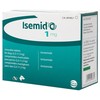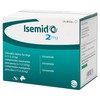Isemid
Isemid Chewable Tablets can be used to treat signs related to congestive heart failure in dogs, including pulmonary oedema. They contain the active ingredient torasemide, which works by increasing the water and salt loss through the urine, which decreases the overall blood volume and thereby reduces the effort needed by the heart to pump blood.
Isemid Tablets are oblong brown tablets that have been scored so that they can be divided into equal halves for easy and accurate dosing.
Isemid 1mg Chewable Tablets for Dogs
£0.49Isemid 1mg Chewable Tablets are indicated for the treatment of clinical signs related to congestive heart failure in dogs, including pulmonary oedema. They work by increasing the loss of...[More info]
Isemid 2mg Chewable Tablets for Dogs
£0.59Isemid 2mg Chewable Tablets are indicated for the treatment of clinical signs related to congestive heart failure in dogs, including pulmonary oedema in dogs weighing 11.5 – 23kg....[More info]
Isemid 4mg Chewable Tablets for Dogs
£0.89Isemid 4mg Chewable Tablets are indicated for the treatment of clinical signs related to congestive heart failure in dogs, including pulmonary oedema in dogs weighing 23 – 60kg. They...[More info]
Contraindications
Do not use in cases of renal failure. Do not use in cases of dehydration, hypovolaemia or hypotension. Do not use concomitantly with other loop diuretics. Do not use in cases of hypersensitivity to the active substance or to any of the excipients.
Special warnings for each target species
The initial/maintenance dose may be temporarily increased when pulmonary oedema becomes more severe, i.e. reaching alveolar oedema state (see section Amounts to be administered and administration route).
Special precautions for use
Special precautions for use in animals
In dogs presenting with acute pulmonary oedema requiring emergency treatment, the use of injectable medicinal products should be considered first before commencing oral diuretic therapy.
Renal function (measurement of blood urea and creatinine as well as urine protein: creatinine (UPC) ratio), hydration status and serum electrolytes status should be monitored prior to and during treatment at very regular intervals according to the benefit-risk assessment performed by the responsible veterinarian (see Contraindications and Adverse reactions). The diuretic response to torasemide may increase over time upon repeated dosing, particularly at doses greater than 0.2 mg/kg/day; therefore more frequent monitoring should be considered.
Torasemide should be used with caution in cases of diabetes mellitus. Monitoring of glycaemia in diabetic animals is recommended prior to and during treatment. In dogs with pre-existing electrolyte and/or water imbalance, this should be corrected prior to treatment with torasemide.
As torasemide increases thirst, dogs should have free access to fresh water. In case of loss of appetite and/or vomiting and/or lethargy or in case of treatment adjustment, renal function (blood urea and creatinine as well as urine protein: creatinine (UPC) ratio) should be assessed.
In a clinical field trial, the efficacy of Isemid was demonstrated when it was used as a first line treatment. Transferring treatment from an alternative loop diuretic to this veterinary medicinal product has not been evaluated and such a change should only be implemented based on a benefit-risk assessment performed by the responsible veterinarian.
The safety and efficacy of the product has not been assessed for dogs weighing less than 2.5 kg. For these animals use only according to the benefit/risk assessment by the responsible veterinarian.
The tablets are flavoured.
Special precautions to be taken by the person administering the veterinary medicinal product to animals
This veterinary medicinal product may cause increased urination, thirst and/or gastrointestinal disturbances and/or hypotension and/or dehydration if ingested. Any part-used tablets should be returned to the blister pack and then to the original carton to help prevent access by children. In case of accidental ingestion, particularly by a child, seek medical advice immediately and show the package leaflet or the label to the physician.
This veterinary medicinal product may cause hypersensitivity (allergic) reactions in persons that are sensitized to torasemide. People with known hypersensitivity to torasemide, to sulphonamides or to any of the excipients should avoid contact with the veterinary medicinal product. If symptoms of allergy occur, seek medical advice and show the product packaging to the physician.
Wash hands after use.
Adverse reactions (frequency and seriousness)
In a clinical field study, renal insufficiency, an increase in renal blood parameters, haemoconcentration and alterations in electrolyte levels (chloride, sodium, potassium, phosphorus, magnesium, calcium) were very commonly observed.
The following clinical signs were observed commonly: episodic gastrointestinal signs such as vomiting and diarrhoea, dehydration, polyuria, polydipsia, urinary incontinence, anorexia, weight loss and lethargy. Other effects consistent with the pharmacological activity of torasemide were observed in pre-clinical studies in healthy dogs at the recommended dose, i.e. dry mucosa of the oral cavity, reversible increases in glucose and aldosterone serum concentrations, decrease in urine specific gravity and increase in urine pH.
Use during pregnancy, lactation or lay
Laboratory studies in rats and rabbits have shown fetotoxicity at maternotoxic doses. As the safety of the product has not been established in the target species, the use of the product is not recommended during pregnancy, lactation and breeding animals.
Interaction with other medicinal products and other forms of interaction
Co-administration of loop diuretics and NSAIDs can result in a decreased natriuretic response. Concomitant use with NSAIDs, aminoglycosides or cephalosporins may increase the risk of nephrotoxicity and/or ototoxicity of those medicinal products. Torasemide may antagonise the action of oral hypoglycaemic agents. Torasemide may increase the risk of sulphonamide allergy.
In cases of co-administration with corticosteroids, the effects of loss of potassium may be potentiated.
In cases of co-administration with amphotericin B, increased potential for nephrotoxicity and intensification of electrolyte imbalance can be observed.
No pharmacokinetic interactions have been reported following co-administration of torasemide with digoxin; however hypokalaemia can enhance digoxin-induced arrhythmias.
Torasemide can reduce the renal excretion of salicylates, leading to an increased risk of toxicity.
Care should be exercised when administering torasemide with other highly plasma protein bound drugs. Since protein binding facilitates the renal secretion of torasemide, a decrease in binding due to displacement by another drug may be a cause of diuretic resistance. Concomitant administration of torasemide with other substances metabolised by cytochrome P450 families 3A4 (e.g.: enalapril, buprenorphine, doxycycline, cyclosporine) and 2E1 (isoflurane, sevoflurane, theophylline) may decrease their clearance from the systemic circulation. The effect of antihypertensive veterinary medicinal products, especially angiotensin converting enzyme (ACE)-inhibitors, may be potentiated when co-administered with torasemide.
Amounts to be administered and administration route
Oral use. The recommended initial/maintenance dose is 0.13 to 0.25 mg torasemide/kg bodyweight/day, once daily. In case of moderate or severe pulmonary oedema, this dose can be increased if necessary up to a maximum dose of 0.4 mg/kg bodyweight/day once daily. Doses of 0.26 mg/kg and higher should only be administered for a maximum period of 5 days. After this period, the dose should be reduced to the maintenance dose and the dog should be evaluated by the veterinarian in a few days.
The dose should be adjusted to maintain patient comfort with attention to renal function and electrolytes status. Once signs of congestive heart failure have been controlled and the patient is stable, it should be continued at the lowest effective dose, if long term diuretic therapy with this product is required. If the tablet is not spontaneously taken by the dog, it can also be given with food or directly into the mouth.
Overdose (symptoms, emergency procedures, antidotes), if necessary
After administration to healthy dogs of 3 times and 5 times the maximum dose for 5 consecutive days followed by 177 daily administrations of 3 times and 5 times the highest therapeutic recommended dose for maintenance, histopathological changes in the kidneys (interstitial inflammation, dilatation of renal tubules and subscapular cysts) were noted in addition to the effects observed after the administration of the recommended dose (see Adverse reactions). The renal lesions were still present at 28 days after the end of treatment. Microscopic characteristics of the lesions suggest an ongoing repair process. These lesions may most likely be considered as a result of the pharmacodynamic effect (diuresis) and were not associated with evidence of glomerulosclerosis or interstitial fibrosis. Transient dose response alterations in the adrenal glands, consisting of minimal to moderate reactive hypertrophy/hyperplasia, presumably related to high production of aldosterone, were observed in the dogs treated with up to 5 times the highest therapeutic recommended dose. An increase in albumin serum concentration was observed. ECG alterations without any clinical signs (increase in P wave and/or QT interval) were observed in some animals after the administration of 5 times the highest recommended dose. The causative role of changes in plasma electrolyte values cannot be excluded.
After administration of 3 and 5 times the highest therapeutic recommended dose to healthy dogs, a decrease of appetite was observed which led to a weight loss in some cases.
In case of overdose, treatment would be at the discretion of the responsible veterinarian, based on the presenting signs.
Withdrawal period(s)
Not applicable.


